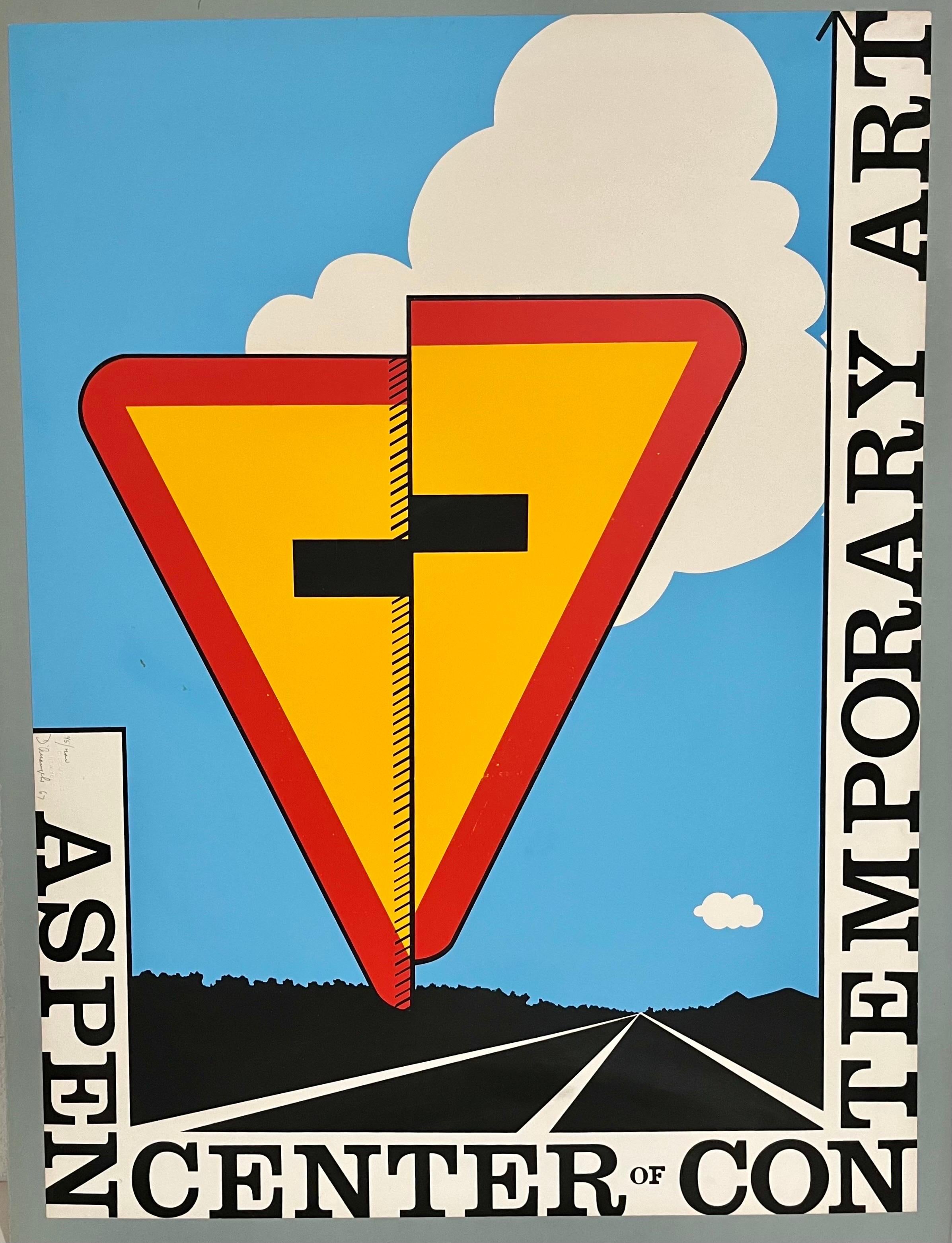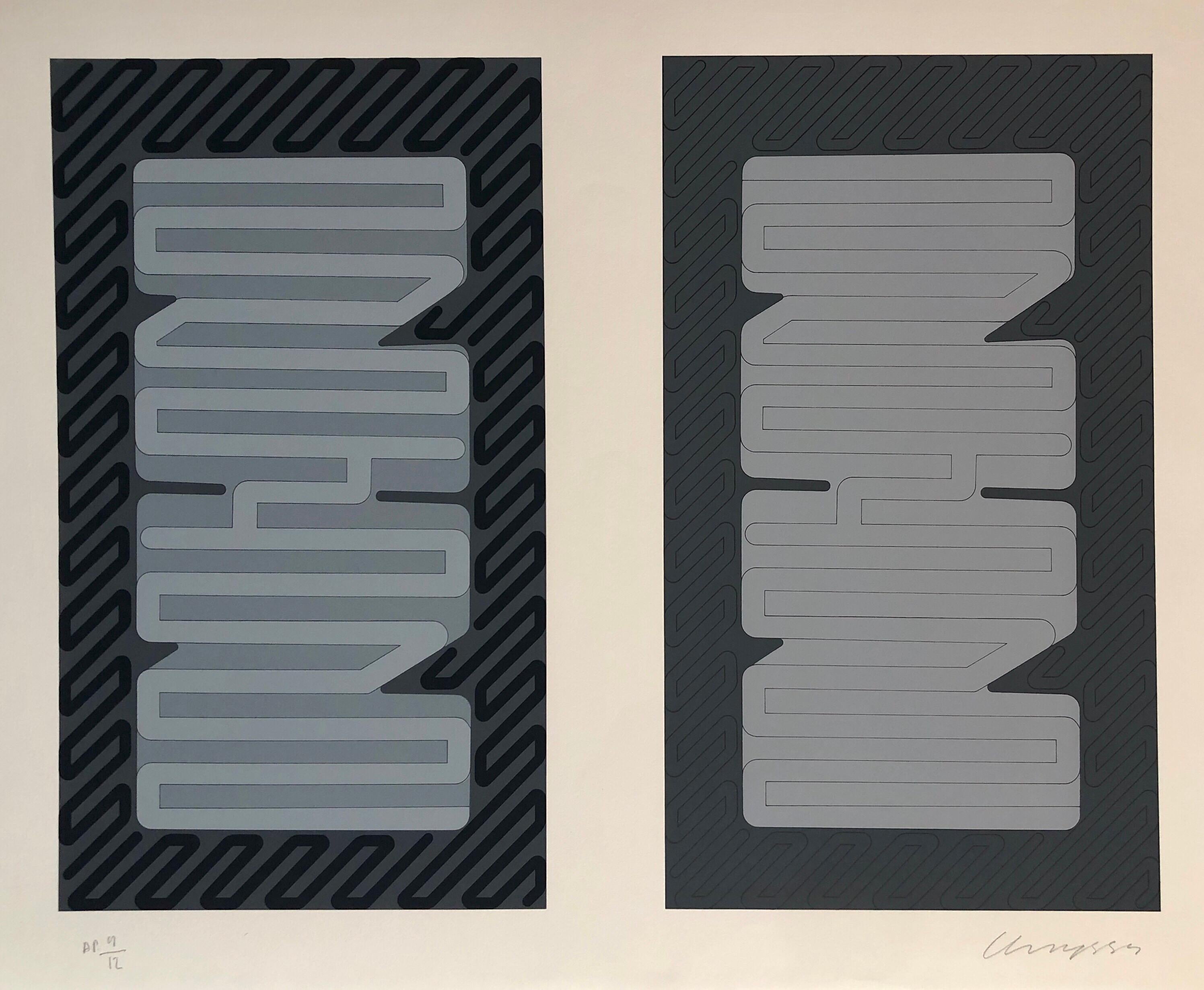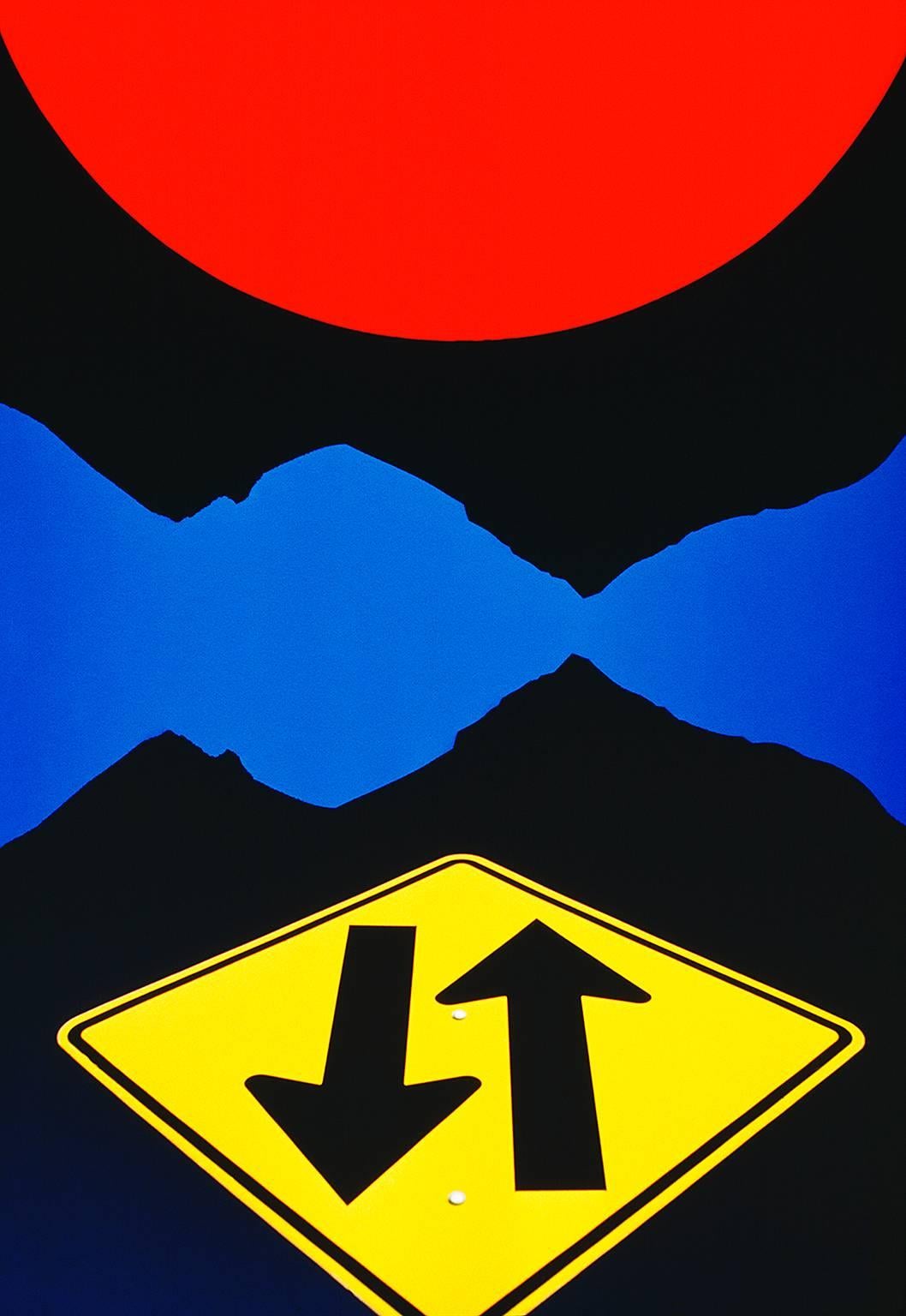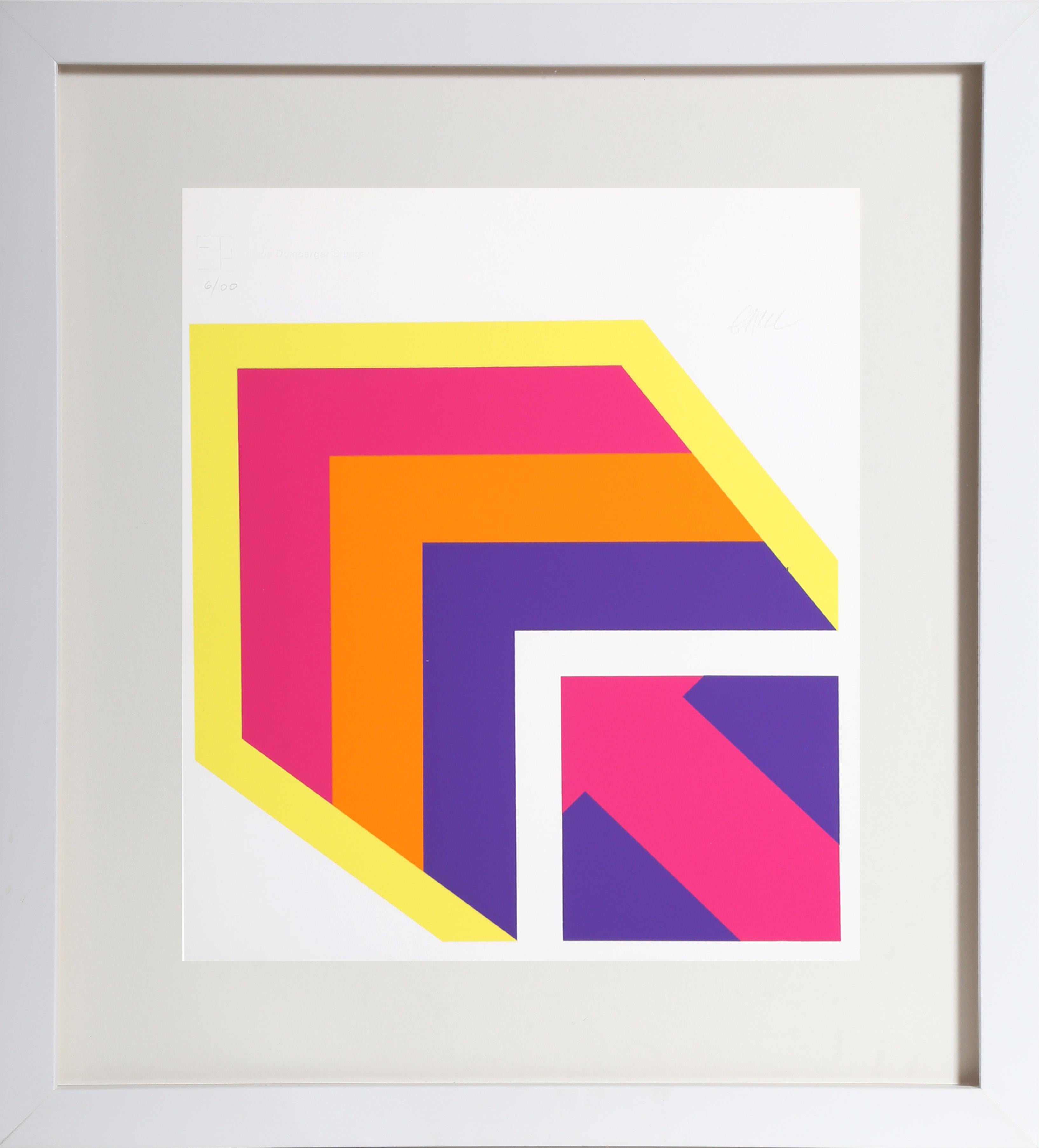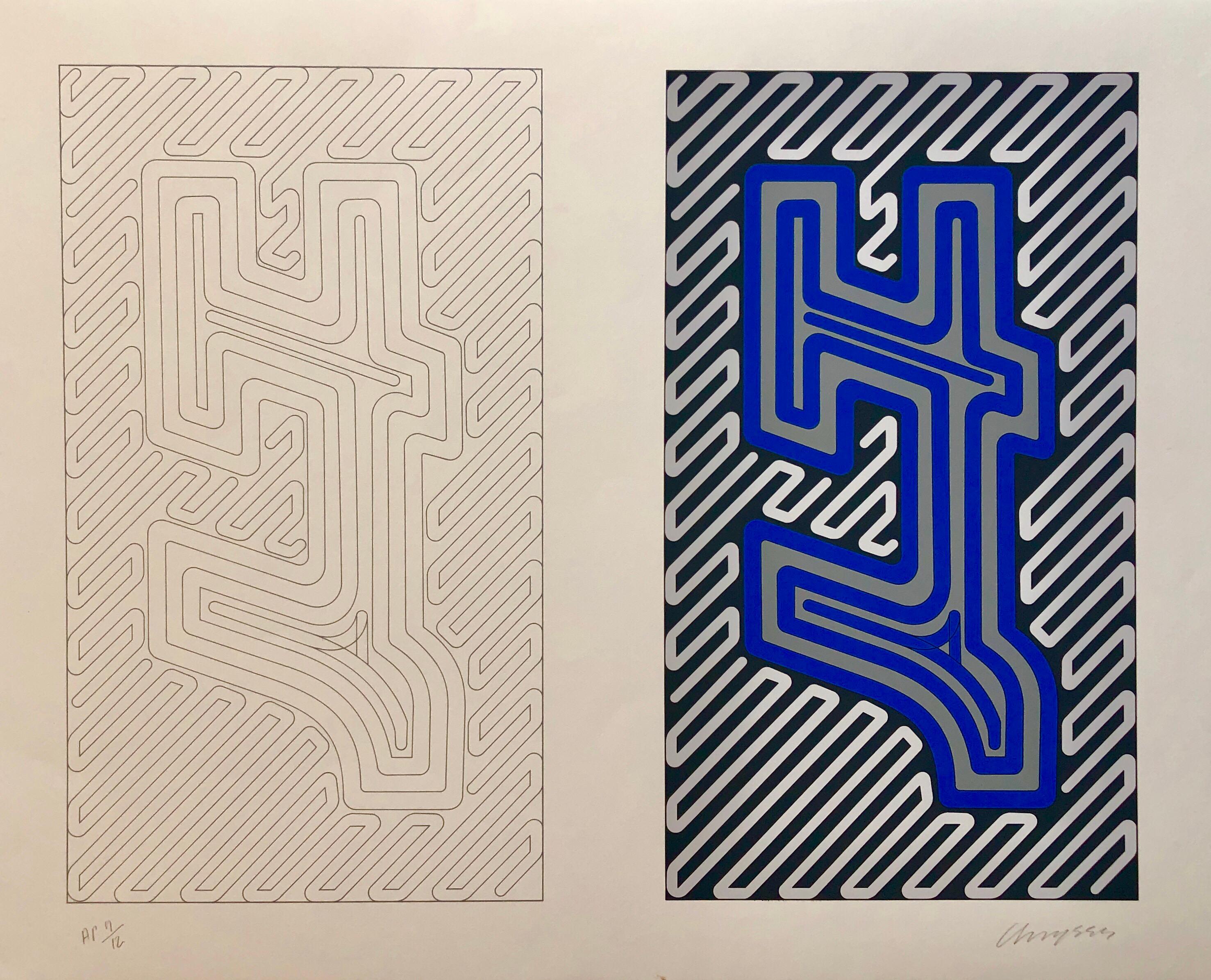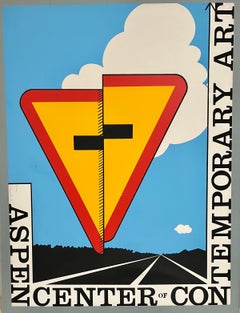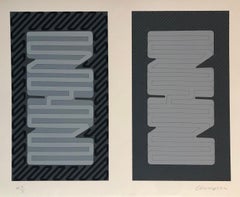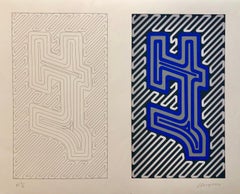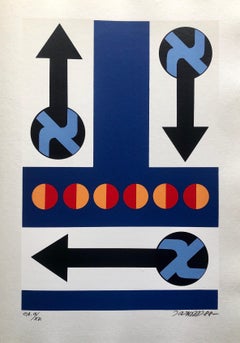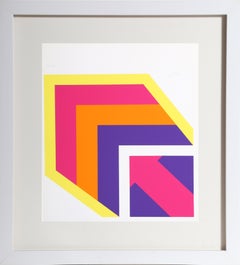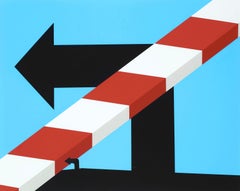Items Similar to Pop Art 1970s Vintage Silkscreen Screen Print Street Signs Titled Calendar
Want more images or videos?
Request additional images or videos from the seller
1 of 12
Paul M. LevyPop Art 1970s Vintage Silkscreen Screen Print Street Signs Titled Calendar1975
1975
$650
£494.70
€566.57
CA$924.52
A$1,013.14
CHF 529.08
MX$12,175.20
NOK 6,614.47
SEK 6,238.50
DKK 4,228.81
About the Item
Printed on heavy Strathmore paper.
Paul Levy (American, b. 1944) An established designer and illustrator, Paul M. Levy was born in Brooklyn, New York, in 1944. He received his B.S. in Industrial Design from the University of
Cincinnati, Ohio in 1968, returning later to do independent study there. He also did independent study at Pratt Institute, Brooklyn, New York, in 1969 and received an M.F.A. in Sculpture and Printmaking from Ohio University, Athens. From 1964 through 1971 he worked for design firms in Ohio, New York and California. From 1971 through 1973 he taught at the University of Cincinnati and Ohio University, Athens. He has exhibited in galleries, museums and art groups. In 1971 he was one of a number of artists who created enormous outdoor murals in a Cincinnati project called "Urban
Walls." His graphic designs and illustrations for such firms as Container Corporation of America have appeared in publications such as Fortune, Business Week and Forbes Magazine. His design for a Cambridge flag appeared on the cover of The Art Gallery. He has done a most unusual and interesting series of illustrations of variations on the United States flag, beginning with one titled "The Right of Assembly" in 1970 which developed into a suite of fifteen prints. He has a collection of American flag artifacts. "I believe that the conditions which govern flag design add another level and dimension to being an artist- designer," he states. His design features the initial "C" for
Cambridge, in thirteen concentric red stripes against white. The stripes recall the appearance of printed circuitry, one product of Cambridge industry. Paul Levy did a well known series depicting artistic representations of a selection of the rights granted to each American under the United States Constitution. Levy, who started the series while living in Cincinnati in 1970 and finished it after moving to Cambridge, Massachusetts, received his artistic training at the University of Cincinnati and earned an MFA from Ohio University in 1973. He did some abstract geometric prints in the style of Vasarely, Agam, Pol Bury, Julio le Parc and the other Denise Rene gallery artists. He also did some Pop Art style prints in the 1970's with Carl Solway gallery.
- Creator:Paul M. Levy (1944, American)
- Creation Year:1975
- Dimensions:Height: 26 in (66.04 cm)Width: 34 in (86.36 cm)
- Medium:
- Movement & Style:
- Period:
- Condition:good. minor wear.
- Gallery Location:Surfside, FL
- Reference Number:1stDibs: LU38213848632
About the Seller
4.9
Platinum Seller
Premium sellers with a 4.7+ rating and 24-hour response times
Established in 1995
1stDibs seller since 2014
1,811 sales on 1stDibs
Typical response time: 1 hour
- ShippingRetrieving quote...Shipping from: Surfside, FL
- Return Policy
Authenticity Guarantee
In the unlikely event there’s an issue with an item’s authenticity, contact us within 1 year for a full refund. DetailsMoney-Back Guarantee
If your item is not as described, is damaged in transit, or does not arrive, contact us within 7 days for a full refund. Details24-Hour Cancellation
You have a 24-hour grace period in which to reconsider your purchase, with no questions asked.Vetted Professional Sellers
Our world-class sellers must adhere to strict standards for service and quality, maintaining the integrity of our listings.Price-Match Guarantee
If you find that a seller listed the same item for a lower price elsewhere, we’ll match it.Trusted Global Delivery
Our best-in-class carrier network provides specialized shipping options worldwide, including custom delivery.More From This Seller
View AllPop Art Aspen Road Sign D'arcangelo Silkscreen Chiron Press Vintage Art Poster
Located in Surfside, FL
Allan D'Arcangelo (American/New York, 1930-1998),
"Aspen Center of Contemporary Art",
1967
silkscreen, hand signed in pencil, dated, numbered "45/200" and blind stamped "Chiron Press, New York, NY"
32 in. x 24 in.
Allan D'Arcangelo (1930-1998) was an American artist and printmaker, best known for his paintings of highways and road signs that border on pop art and minimalism, precisionism, Abstract illusionism and hard-edge painting, and also surrealism. His subject matter is distinctly American and evokes, at times, a cautious outlook on the future of this country. Allan D'Arcangelo was the son of Italian immigrants. He studied at the University of Buffalo from 1948–1953, where he got his bachelor's degree in history. After college, he moved to Manhattan and picked up his studies again at the New School of Social Research and the City University of New York, City College. At this time, he encountered Abstract Expressionist painters who were in vogue at the moment. After joining the army in the mid 1950s, he used the GI Bill to study painting at Mexico City College from 1957–59, driving there over 12 days in an old bakery truck retrofitted as a camper. However, he returned to New York in 1959, in search of the unique American experience. It was at this time that his painting took on a cool sensibility reminiscent of Roy Lichtenstein and Andy Warhol. His interests engaged with the environment, anti-Vietnam War protests, and the commodification and objectification of female sexuality. D'Arcangelo first achieved recognition in 1962, when he was invited to contribute an etching to The International Anthology of Contemporary Engraving: America Discovered; his first solo exhibition came the next year, at the Thiebaud Gallery in New York City. In 1965 he contributed three screenprints to Original Edition's 11 Pop Artists portfolio. By the 1970s, D'Arcangelo had received significant recognition in the art world. He was well known for his paintings of quintessentially American highways and infrastructure, and in 1971 was commissioned by the Department of the Interior to paint the Grand Coulee Dam in Washington state. However, his sense of morality always trumped his interest in art world fame. In 1975, he decided to quit the gallery that had been representing him for years, Marlborough Gallery, because of the way they handled Mark Rothko legacy.
D'Arcangelo rejected Abstract Expressionism, though his early work has a painterly and somewhat expressive feel. He quickly turned to a style of art that seemed to border on Pop Art and Minimalism, Precisionism and Hard-Edge painting. Evidently, he didn't fit neatly in the category of Pop Art, though he shared subjects (women, signs, Superman) and techniques (stencil, assemblage) with these artists.He turned to expansive, if detached scenes of the American highway. These paintings are reminiscent of Giorgio de Chirico-though perhaps not as interested in isolation-and Salvador Dali-though there is a stronger interest in the present and disinterest in the past. These paintings also have a sharp quality that is reminiscent of the precisionist style, or more specifically, Charles Sheeler. 1950s, Before D'Arcangelo returned to New York, his style was roughly figurative and reminiscent of folk art. During the early 1960s, Allan D'Arcangelo was linked with Pop Art. "Marilyn" (1962) depicts an illustrative head and shoulders on which the facial features are marked by lettered slits to be "fitted" with the eyebrows, eyes, nose and mouth which appear off to the right in the composition. In "Madonna and Child," (1963) the featureless faces of Jackie Kennedy and Caroline are ringed with haloes, enough to make their status as contemporary icons perfectly clear.
Select Exhibitions:
Fischbach Gallery, New York,
Ileana Sonnabend Gallery, Paris,
Gallery Müller, Stuttgart, Germany
Hans Neuendorf Gallery, Hamburg, Germany
Dwan Gallery...
Category
1960s Pop Art Abstract Prints
Materials
Lithograph, Screen
1970's Large Silkscreen Abstract Geometric Day Glo Serigraph Pop Art Print Neon
By Chryssa Vardea-Mavromichali
Located in Surfside, FL
Silkscreen on Arches paper, Hand signed and Numbered in Pencil. Serigraph in black, gray (silver).
Chryssa Vardea-Mavromichali (Greek: Χρύσα Βαρδέα-Μαυρομιχάλη; December 31, 1933 – December 23, 2013) was a Greek American artist who worked in a wide variety of media. An American art pioneer in light art and luminist sculpture widely known for her neon, steel, aluminum and acrylic glass installations, she has always used the mononym Chryssa professionally. She worked from the mid-1950s in New York City studios and worked since 1992 in the studio she established in Neos Kosmos, Athens, Greece.
Chryssa was born in Athens into the famous Mavromichalis family from the Mani Peninsula. one of her sisters, who studied medicine, was a friend of the poet and novelist Nikos Kazantzakis.
Chryssa began painting during her teenage years and also studied to be a social worker.In 1953, on the advice of a Greek art critic, her family sent her to Paris to study at the Académie de la Grande Chaumiere where Andre Breton, Edgard Varese, and Max Ernst were among her associates and Alberto Giacometti was a visiting professor.
In 1954, at age twenty-one, Chryssa sailed for the United States, arrived in New York and went to San Francisco, California to study at the California School of Fine Arts. Returning to New York in 1955, she became a United States citizen and established a studio in the city.
Chryssa's first major work was The Cycladic Books preceded American minimalism by seventeen years.
1961, Chryssa's first solo exhibition was mounted at The Guggenheim.
1963, Chryssa's work was shown at the Museum of Modern Art in curator Dorothy Canning Miller's Americans 1963 exhibition. The artists represented in the show also included Richard Anuszkiewicz, Lee Bontecou, Robert Indiana, Richard Lindner, Marisol, Claes Oldenburg, Ad Reinhardt, James Rosenquist and others.
1966, The Gates to Times Square, regarded as "one of the most important American sculptures of all time" and "a thrilling homage to the living American culture of advertising and mass communications." The work is a 10 ft cube installation of two huge letter 'A's through which visitors may walk into "a gleaming block of stainless steel and Plexiglas that seems to quiver in the play of pale blue neon light" which is controlled by programmed timers. First shown in Manhattan's Pace Gallery, it was given to the Albright-Knox Art Gallery in Buffalo, New York in 1972.
1972, The Whitney Museum of American Art mounted a solo exhibition of works by Chryssa.
That's All (early 1970s), the central panel of a triptych related to The Gates of Times Square, was acquired by the Museum of Modern Art between 1975 and 1979.
1973, Chryssa's solo exhibition at the Gallerie Denise René was reviewed for TIME magazine by art critic Robert Hughes before it went on to the Galleries Denise René in Düsseldorf and Paris.
Other works by Chryssa in composite honeycomb aluminum and neon in the 1980s and 1990s include Chinatown, Siren, Urban Traffic, and Flapping Birds.
Chryssa 60/90 retrospective exhibition in Athens in the Mihalarias Art Center. After her long absence from Greece, a major exhibition including large aluminum sculptures - cityscapes, "neon boxes" from the Gates to the Times Square, paintings, drawings etc. was held in Athens.
In 1992, after closing her SoHo studio, which art dealer Leo Castelli had described as "one of the loveliest in the world," Chryssa returned to Greece. She found a derelict cinema which had become a storeroom stacked with abandoned school desks and chairs, behind the old Fix Brewery near the city center in Neos Kosmos, Athens. Using the desks to construct enormous benches, she converted the space into a studio for working on designs and aluminum composite honeycomb sculptures...
Category
1980s Pop Art Abstract Prints
Materials
Screen
1970's Large Silkscreen Abstract Geometric Day Glo Serigraph Pop Art Print Neon
By Chryssa Vardea-Mavromichali
Located in Surfside, FL
Silkscreen on Arches paper, Hand signed and Numbered in Pencil. Serigraph in white, back, blue gray (silver).
Chryssa Vardea-Mavromichali (Greek: Χρύσα Βαρδέα-Μαυρομιχάλη; December 31, 1933 – December 23, 2013) was a Greek American artist who worked in a wide variety of media. An American art pioneer in light art and luminist sculpture widely known for her neon, steel, aluminum and acrylic glass installations, she has always used the mononym Chryssa professionally. She worked from the mid-1950s in New York City studios and worked since 1992 in the studio she established in Neos Kosmos, Athens, Greece.
Chryssa was born in Athens into the famous Mavromichalis family from the Mani Peninsula. one of her sisters, who studied medicine, was a friend of the poet and novelist Nikos Kazantzakis.
Chryssa began painting during her teenage years and also studied to be a social worker.In 1953, on the advice of a Greek art critic, her family sent her to Paris to study at the Académie de la Grande Chaumiere where Andre Breton, Edgard Varese, and Max Ernst were among her associates and Alberto Giacometti was a visiting professor.
In 1954, at age twenty-one, Chryssa sailed for the United States, arrived in New York and went to San Francisco, California to study at the California School of Fine Arts. Returning to New York in 1955, she became a United States citizen and established a studio in the city.
Chryssa's first major work was The Cycladic Books preceded American minimalism by seventeen years.
1961, Chryssa's first solo exhibition was mounted at The Guggenheim.
1963, Chryssa's work was shown at the Museum of Modern Art in curator Dorothy Canning Miller's Americans 1963 exhibition. The artists represented in the show also included Richard Anuszkiewicz, Lee Bontecou, Robert Indiana, Richard Lindner, Marisol, Claes Oldenburg, Ad Reinhardt, James Rosenquist and others.
1966, The Gates to Times Square, regarded as "one of the most important American sculptures of all time" and "a thrilling homage to the living American culture of advertising and mass communications." The work is a 10 ft cube installation of two huge letter 'A's through which visitors may walk into "a gleaming block of stainless steel and Plexiglas that seems to quiver in the play of pale blue neon light" which is controlled by programmed timers. First shown in Manhattan's Pace Gallery, it was given to the Albright-Knox Art Gallery in Buffalo, New York in 1972.
1972, The Whitney Museum of American Art mounted a solo exhibition of works by Chryssa.
That's All (early 1970s), the central panel of a triptych related to The Gates of Times Square, was acquired by the Museum of Modern Art between 1975 and 1979.
1973, Chryssa's solo exhibition at the Gallerie Denise René was reviewed for TIME magazine by art critic Robert Hughes before it went on to the Galleries Denise René in Düsseldorf and Paris.
Other works by Chryssa in composite honeycomb aluminum and neon in the 1980s and 1990s include Chinatown, Siren, Urban Traffic, and Flapping Birds.
Chryssa 60/90 retrospective exhibition in Athens in the Mihalarias Art Center. After her long absence from Greece, a major exhibition including large aluminum sculptures - cityscapes, "neon boxes" from the Gates to the Times Square, paintings, drawings etc. was held in Athens.
In 1992, after closing her SoHo studio, which art dealer Leo Castelli had described as "one of the loveliest in the world," Chryssa returned to Greece. She found a derelict cinema which had become a storeroom stacked with abandoned school desks and chairs, behind the old Fix Brewery near the city center in Neos Kosmos, Athens. Using the desks to construct enormous benches, she converted the space into a studio for working on designs and aluminum composite honeycomb sculptures...
Category
1980s Pop Art Abstract Prints
Materials
Screen
Hungarian Surrealism Pop Art Hebrew Silkscreen Judaica Print Jewish Serigraph
By Jozsef Jakovits
Located in Surfside, FL
Abstract Hebrew Prints on heavy mould made paper from small edition of 15. there is a facing page of text in Hungarian folded over. Hard edged geometric abstract prints in color base...
Category
1980s Pop Art Abstract Prints
Materials
Archival Paper, Screen
Abstract Minimalist Color Silkscreen Print Richard Smith On The Bowery Pop Art
By Richard Smith
Located in Surfside, FL
Richard Smith
On the Bowery, 1969 - 1971
silkscreen on Schoeller's Parole Paper, edition of 100 + 20 A.P.
25.5 x 25.5 inches, signed, numbered 21/100
Screenprint in color on wove pa...
Category
1960s Pop Art Abstract Prints
Materials
Lithograph, Screen
Abstract Geometric 1970s Vintage Silkscreen Screen Print Manner of Vasarely
By Paul M. Levy
Located in Surfside, FL
Paul Levy (American, b. 1944) An established designer and illustrator, Paul M. Levy was born in Brooklyn, New York, in 1944. He received his B.S. in Industrial Design from the University of
Cincinnati, Ohio in 1968, returning later to do independent study there. He also did independent study at Pratt Institute, Brooklyn, New York, in 1969 and received an M.F.A. in Sculpture and Printmaking from Ohio University, Athens. From 1964 through 1971 he worked for design firms in Ohio, New York and California. From 1971 through 1973 he taught at the University of Cincinnati and Ohio University, Athens. He has exhibited in galleries, museums and art groups. In 1971 he was one of a number of artists who created enormous outdoor murals in a Cincinnati project called "Urban
Walls." His graphic designs and illustrations for such firms as Container Corporation of America have appeared in publications such as Fortune, Business Week...
Category
1970s Abstract Geometric Abstract Prints
Materials
Screen
You May Also Like
Abstract Street Signs and Shapes, Modern Photography Cover
By Mitchell Funk
Located in Miami, FL
Modern Photography Cover , August 1978
This image is signed, dated and numbered 2/15 lower right recto. Other sizes are available. Printed on Hahnemühle Fine Art paper . The work is ...
Category
1970s Abstract Geometric Abstract Photography
Materials
Photographic Paper
May, OP Art Print by Winfred Gaul 1969
By Robert Indiana
Located in Long Island City, NY
Artist: Winfred Gaul, German (1928–2003)
Title: May
Year: 1969
Medium: Silkscreen, signed and numbered in pencil
Edition: 6/100
Size: 14 x 12 in. (35.56 x 30.48 cm)
Frame: 20 x 18 in...
Category
1960s Pop Art Abstract Prints
Materials
Screen
Forever Chic, Geometric Pop Art Screenprint by Allan D'Arcangelo
By Allan D'Arcangelo 1
Located in Long Island City, NY
Artist: Allan D'Arcangelo, American (1930 - 1998)
Title: Forever Chic
Year: 1979
Medium: Screenprint, signed and numbered in pencil
Edition: AP 15/25
Image Size: 40 x 28 inches
Size...
Category
1970s Pop Art More Prints
Materials
Screen
U.S. Highway #1, Allan D'Arcangelo
Located in Fairfield, CT
Artist: Allan D’Arcangelo (1930-1998)
Title: U.S. Highway #1
Year: 1978
Edition: 99/150, plus proofs
Medium: Silkscreen on Arches paper
Size: 26 x 30.25 inches
Inscription: Signed an...
Category
1970s Pop Art Abstract Prints
Materials
Screen
$1,036 Sale Price
20% Off
Road Sign, Abstract Lithograph by Alexander Liberman
By Alexander Liberman
Located in Long Island City, NY
Road Sign by Alexander Liberman, Ukranian/American (1912–1999)
Date: 1969
Screenprint on Rives, signed, numbered and dated in pencil
Edition: AP
Size: 32.5 x 22.75 in. (82.55 x 57.79...
Category
1960s Abstract Expressionist Abstract Prints
Materials
Screen
1971 "Ein Domberger Siebdruck-Kalender" Max Bill Silkscreen
By Max Bill
Located in Arp, TX
Max Bill
"Primary Colors"
1971
Silkscreen on paper edition of 2375
"Ein Domberger Siebdruck-Kalender"
11.75"x14" unframed
Unsigned
Born in Switzerland, Max Bill was an artist widely...
Category
1970s Abstract Abstract Prints
Materials
Paper, Screen
More Ways To Browse
Geometric Art Vintage
Retro Pop Art Style
Vintage Calendars
Vintage Street Sign
1970 Calendar Print
Joseph Presser
Karl Georg Pfahler
Leon Underwood
Lichtenstein Serigraph
Minimal Print Ink
Miro 1978
Miro Terres De Grand Feu
Montreal Olympics
Motherwell Signed Prints
Poster Jean Dubuffet
Primo Conti
Richard Diebenkorn Lithographs
Richard Serra Poster
